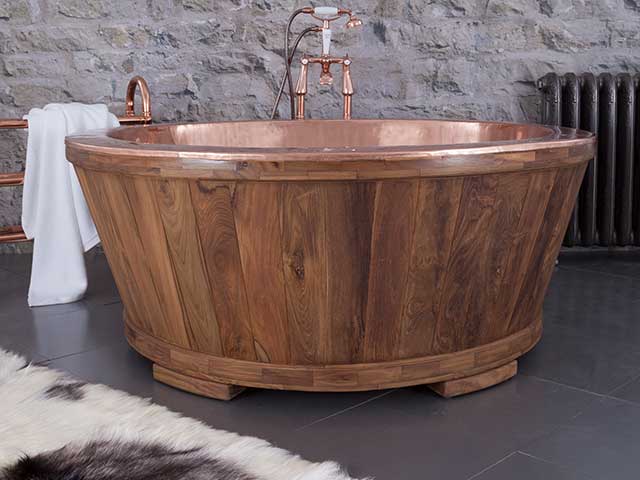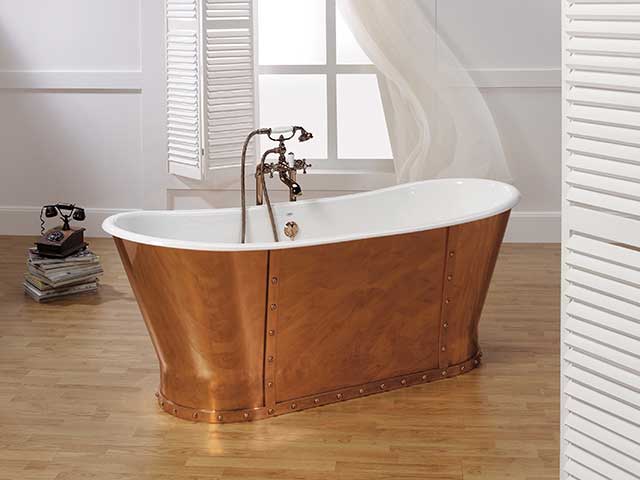Copper bathtubs: the pros and cons
This classic style requires some upkeep, so make sure you're well informed before buying
A freestanding copper bathtub makes for an impressive feature in both traditional and contemporary schemes – but it may also represent a significant investment, with prices ranging from £3,000 up to £10,000.
So, if a copper tub is your idea of bathing bliss, make sure you know the pros and cons before taking the plunge…
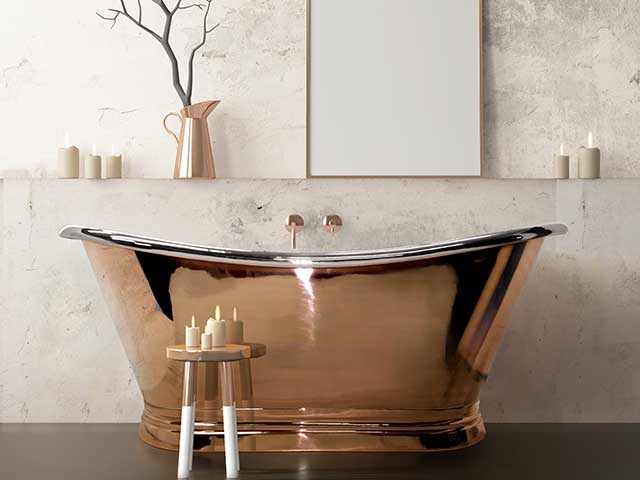
BC Designs copper boat double ended bath from UK Bathrooms
The pros and cons of a copper bath
In hot water
Copper is a great conductor of heat – this means that when the bath is filled, the water retains an even temperature throughout.
It will also stay hotter for longer, better than in a cast iron bath, for instance – so copper is ideal if you like long, relaxing soaks.
Some copper tubs are lined with another material, such as nickel or enamel with these options sometimes being less expensive than a pure copper bath.
Nickel conducts heat well, though not as well as copper. Enamel lined interiors offer a more traditional look.
Better hygiene?
Copper has antimicrobial properties, meaning it can kill microorganisms like bacteria and viruses – including Covid-19.
“Copper kills bacteria and viruses without help from cleaning products,” says Barrie Cutchie, design director of BC Designs.
Easier, more eco-friendly cleaning is definitely a bonus.
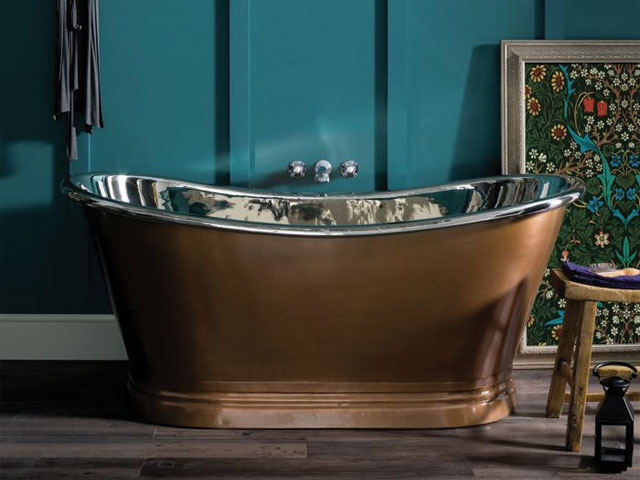
Antique copper/nickel boat bath from BC Designs
A weighty issue
A copper freestanding bath is fairly heavy in comparison to an acrylic or enamelled steel tub. “On average, our copper baths weigh 45kg,” says manufacturer William Holland.
“To put this in perspective, a cast iron bath weighs 250kg, often needing reinforced floors and a whole team to install.”
Limited shapes
Bateau styles are the most common.
This type of bath is deep with high sides, and offers a more upright bathing experience than a standard tub – but shoulders and knees are always submerged in the water, so you’ll still be able to soak and unwind in comfort.
Want to take your copper bath relaxation up a notch? Achieve ultimate, hotel-inspired bathing bliss by sticking a freestanding bath in your bedroom…
Are copper baths comfortable?
The ultimate goal of a new bath is one that you can relax and unwind in after a long day.
This means that being comfortable is essential criteria.
You’re in luck, as they offer a luxurious and comfortable bathing experience which isn’t always clear from the outside with the rustic appearance.
They have exceptional heat retention, which is ideal for comfort as you can enjoy a warmer soak for longer.
The ergonomic design also oozes comfort as you can prop your back against the edge and really relax.
Are copper baths hard to keep clean?
Copper baths can be tricky to clean, especially if you want them to look dazzling for a long time and therefore, worthy of the price tag.
It’s best to be gentle but regular with your cleaning.
Copper is naturally resistant to mould and bacteria, so it doesn’t need aggressive cleaners, but it can fall victim to stubborn stains from hard water or soap.
Polishing regularly is essential, and watch the video below for more maintenance tips for copper baths.
How to keep a copper bath in top condition
Copper will develop a patina over time – regular maintenance is the key to preserving the original finish.
Watch this BC Designs video tutorial on copper maintenance for expert advice on caring for your copper bath tub.
Buyer’s guide to copper baths
Are you sold on the idea of a copper bath to complete your stunning new bathroom refurb?
Choose the right one for you with this guide to the best copper baths on the market right now.
Copper freestanding boat bath
As one of the first brands we think of when we consider a luxury, spa-style bathroom, BC Designs had to be top of our list.
This stunning, copper freestanding boat bath is handmade with the classic roll top design.
It will make a statement in your bathroom and look great with plenty of different colour schemes.
Speaking of which, you are also able to order this copper bath to have the exterior painted in any Farrow & Ball or Little Greene eggshell finish paint – sou can personalise it to your unique bathroom, should you wish.
The copper freestanding boat bath is 725mm x 725mm x 1500mm and is double ended, so you can choose whichever side you’d like to languish in after a hard day.
It’s floor mounted and has a ten year guarantee, so you have peace of mind with your purchase.
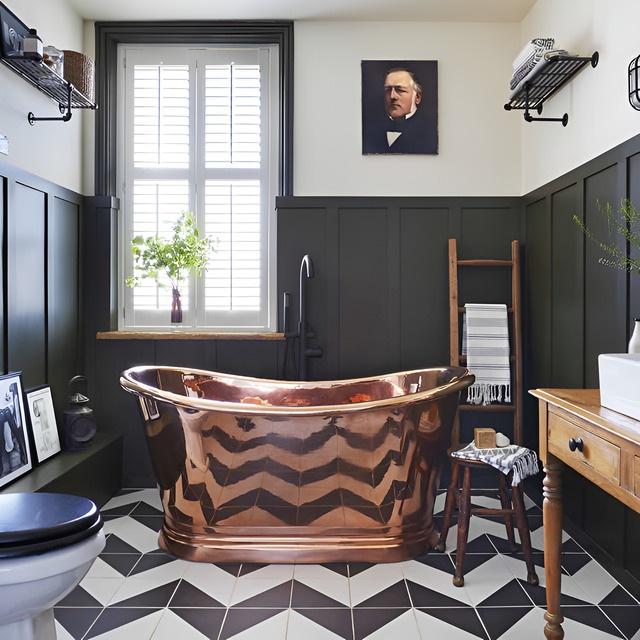
Photo: Sanctuary Bathrooms
- BC Designs 1500mm x 725mm Copper Freestanding Boat Bath, £4,246.20 from Sanctuary Bathrooms – buy here
Oxidised Copper Bath
This freestanding tub is handmade in the bateau-style. It has a beautiful mottled, turquoise patina, layered over the highly polished tin.
The unique finish is created from salt being applied to the metal and heating the surface until the distinct turquoise colour and texture is achieved.
Due to the hand finished touches, these baths can have some imperfections, but these will add to the character of a truly distinctive piece.
It’s a truly statement piece and will be an exquisite feature of your bathroom.
The Oxidised Copper Bath has a weight capacity of 45kg and a water capacity of 450 litres.
It’s available in three different sizes, so you can decide depending on the space you have available.
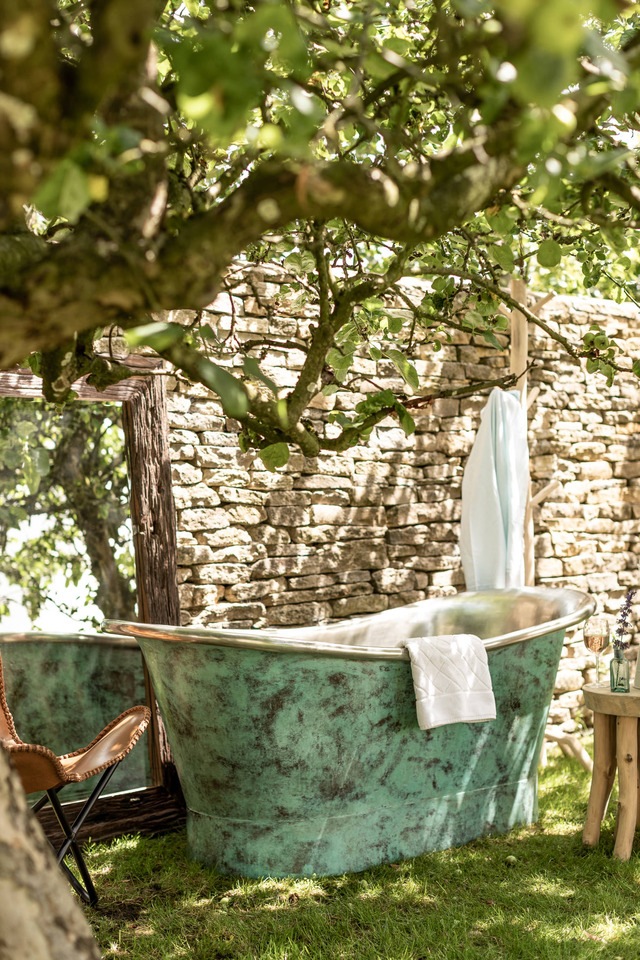
Photo: Indigenous
- Oxidised Copper Bath, from £2,997 from Indigenous – buy here
Trafalgar Copper Double Ended Slipper Roll Bath
Luxurious and stunning to look at, the Trafalgar 1500 classic roll top double-ended slipper bath is crafted from polished high-gauge copper with a nickel interior.
It serves as a focal point for your bathroom space and fits into both traditional and contemporary designs.
If you’re wanting to make a statement with your new bathroom, this is the way to do it.
There is flexibility within this design, too, as you can use with wall-mounted or floor-mounted freestanding bath taps, to further showcase the luxury look.
The Trafalgar Copper is 1500mmx710mmx710mm and has a copper exterior with a nickel interior.
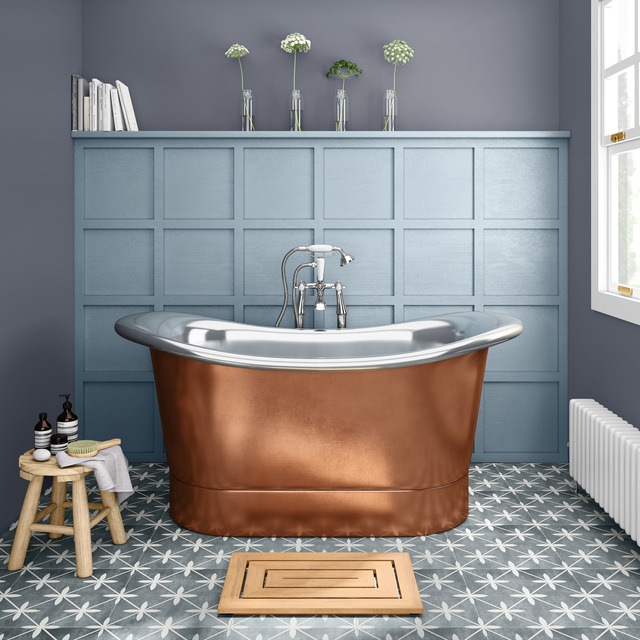
Photo: Victorian Plumbing
- Trafalgar Copper Double Ended Slipper Roll Bath, £2,499.95 – buy here
Hurlingham – Copper Nickel Bijou Compact
This two-toned Hurlingham beauty offers the smallest of bathrooms a boost of elegance.
The Bijou compact bath is the perfect balance of functionality and practicality with a small bath design and high slipper effect. It stands at 1250mmx730mm.
This still allows you to be able to stretch out and enjoy a deep soak whilst being comfortable.
Simply rest your head on the lip of the bath so you can literally spend hours (thanks to the heat retention) relaxing in this small copper bath.
Hurlingham also offer a bespoke finish to give your copper bath that magic finishing touch.
Choose from leather wrapped baths, to gold leaf gilding or marble effects and stencil lines.
Just Baths offer a five year warranty with this bath and it’s worth noting that the waste is not included, nor is the overflow pre-drilled.
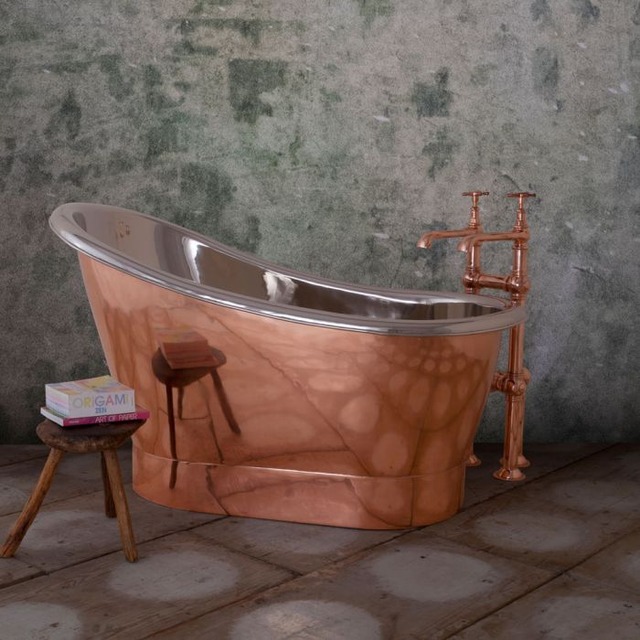
Photo: Just Baths
- Hurlingham Copper Nickel Bijou Compact bath, £3,673 from Just Baths – buy here
Freestanding Soaking Copper Bathtub
Unique with its antique hammered finish on both the inside and outside, this gauge, lead-free copper bath from Wayfair is really beautiful.
It has a roll top pipe and slanting base design, and measures at 1900mmx920mmx750mm.
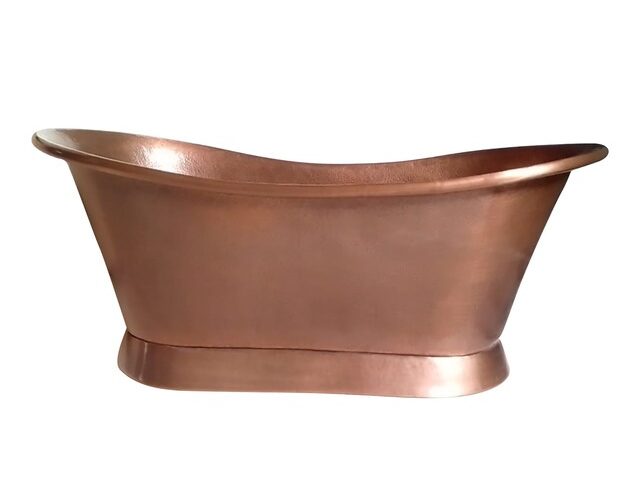
Photo: Wayfair
- Freestanding Soaking Copper Bathtub, £4,899.99 from Wayfair – buy here
Luxury freestanding bathtub in copper
Taken from the B&Q Elementa collection, this beautifully designed and handcrafted freestanding copper bath is the perfect fit for your new bathroom.
It’s available in a variety of metallic or marble effect finishes and sizes, so there is bound to be a bath suitable to promote the impression you choose.
Whether that’s a contemporary finish or something more traditional and period design.
All Elementa baths are constructed from tough and durable acrylic, which is sprayed and finished with a coloured film coating for extra protection.
This bath offers a ten year guarantee and measures 1495mmx580mmx745mm.
- Luxury freestanding bathtub, £1,599 from B&Q – buy here
READ MORE


